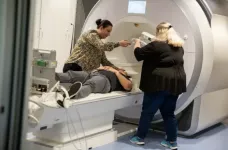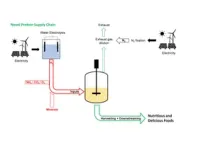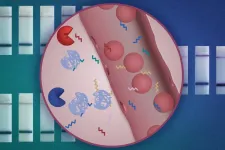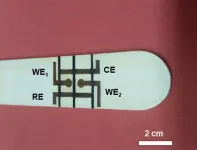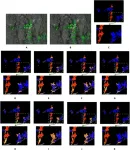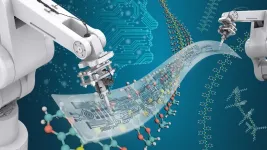(Press-News.org) 1. Introduction
While the pathophysiology of Parkinson’s disease (PD) is not fully understood, it has been traditionally linked to a reduction in the dopamine available to brain regions involved in motor control (Alexander, 2004, Brooks, 2010, Fahn, 2008, Meder et al., 2019, Obeso et al., 2017, Poewe et al., 2017). It is important to note that much of what is known about the neural bases of motor deficits in PD is based on task-based functional magnetic resonance imaging (fMRI) studies showing abnormal motor-related blood oxygen level dependent (BOLD) activation patterns in PD compared to healthy older adults (Burciu and Vaillancourt, 2018, Herz et al., 2014, Herz et al., 2021, Niethammer et al., 2012). A recent coordinate-based meta-analysis of functional neuroimaging studies testing limb movements in PD and healthy individuals revealed consistent hypoactivation of the posterior putamen and cerebellum in PD compared to controls during a variety of motor tasks (Herz et al., 2021). The primary motor cortex (M1) and the supplementary motor area (SMA) also showed a lower degree of activation in PD across multiple studies, whereas areas localized anterior to these structures were found to be hyperactive (Herz et al., 2021).
While the imaging research carried out to date in PD points to functional abnormalities along distinct neural pathways, it is important to note that most imaging studies in PD are upper limb studies. Despite the significant impact of lower limb symptoms on everyday life activities in PD, the neural correlates of lower limb deficits have received little attention. This knowledge is limited in part by the technical difficulties in performing controlled experiments with currently available fMRI methods. First and foremost, head motion is known to have a substantial impact on the results of fMRI studies (Friston et al., 1996, Power et al., 2012), and movements of the feet in a supine position could lead to greater disruption of the fMRI signal than movements of the hands. Of note, the coordinate-based meta-analysis cited above, upon the application of strict exclusion criteria, identified only two studies involving movement execution in the lower limb in PD out of thirty-nine functional studies (Herz et al., 2021). Recently, studies focusing on unique PD phenotypes (PD with freezing of gait or PD with postural instability and gait disturbances) have emerged, emphasizing the need for better understanding of lower limb deficits in PD (Agosta et al., 2017, de Lima-Pardini et al., 2017, Gilat et al., 2019, Matar et al., 2019, Piramide et al., 2020, Sarasso et al., 2021, Shine et al., 2013).
Due to differences in the tasks employed, PD phenotypes tested, as well as the relatively small number of participants in some studies, there is no clear consensus regarding the functional brain changes associated with lower limb dysfunction in PD has not been reached yet (Agosta et al., 2017, de Lima-Pardini et al., 2017, Drucker et al., 2019, Gilat et al., 2019, Katschnig et al., 2011, Matar et al., 2019, Piramide et al., 2020, Sarasso et al., 2021, Shine et al., 2013). Some results point to a reduction in activation of the striatum and sensorimotor regions, whereas other results indicate an excess of activation in premotor regions such as the SMA, pre-SMA, frontal areas and specific subdivisions of the cerebellum (Drucker et al., 2019, Katschnig et al., 2011, Piramide et al., 2020, Sarasso et al., 2021, Shine et al., 2013). Together, disparate results point to a major need to conduct more lower limb studies in PD to better understand the pathophysiology of lower limb symptoms in this population. Equally important is the need to increase the validity of research studies by additionally accounting for task performance. Parameters such as the amplitude of movements or the number of iterations can vary between PD and controls, which may account for reported differences in activation patterns.
Given that knowledge about the effect of PD on the neural circuits controlling lower limb movements is limited, the purpose of this fMRI study was to further investigate the neural correlates of lower limb function in PD vs. healthy older adults by using 1) a novel MRI-compatible ankle dorsiflexion device that produces minimal head motion and 2) a force control paradigm highly sensitive to PD deficits We administered a well-established PD force paradigm (Burciu et al., 2016a, Burciu et al., 2016b, Burciu et al., 2015, Chung et al., 2018, Neely et al., 2015, Planetta et al., 2015, Prodoehl et al., 2010, Spraker et al., 2010) to characterize and compare the fMRI correlates of lower limb function in PD and a group of matched older adults. We hypothesized that both the cortico-basal ganglia and cortico-cerebellar motor circuits will be hypoactive in PD compared to healthy older adults.
2. Participants and clinical assessments
Twenty-four PD and twenty-one healthy older adults completed this study. PD participants were diagnosed by a movement disorder specialist using established criteria (i.e., United Kingdom PD Society Brain Bank Criteria) and were recruited either from the Christiana Care Neurology Specialists Clinic in Newark, Delaware, or the University of Delaware Participant Recruitment Registry for Parkinson’s Disease Research. PD patients were excluded if they had: concurrent movement disorders (e.g., dystonia), an atypical form of parkinsonism, dementia, neuropsychiatric disorders, musculoskeletal disorders, a history of cancer that required chemotherapy and/or radiotherapy or have undergone deep brain stimulation surgery for the treatment of PD symptoms. T2-weighted MRI scans were also collected as part of this study for the purpose of excluding secondary causes of parkinsonism/other pathophysiology (e.g., vascular lesions, demyelinating lesions, tumors, etc.). Upon inspection of the MRI scans, no participant was excluded from the analysis. The older adults in the control group were recruited via advertisements in the Newark area and reported no history of neurological or neuropsychiatric disorders. Of note, PD and controls were matched at the group level for age, sex, cognitive status, and tested side (Table 1). PD participants were tested on their more affected side which could be either the dominant or non-dominant side. The tested side in controls was randomized so that there were no statistically significant group differences in the ratio of people tested on their left/right side or dominant/non-dominant side. Importantly, all testing occurred in the morning, with PD patients being tested following an overnight withdrawal from antiparkinsonian medication (∼12 h after the last dose of PD medication). The Montreal Cognitive Assessment Test (MOCA) (Nasreddine et al., 2005) was used to screen for cognitive impairment, and the motor section of the Movement Disorder Society Unified Parkinson’s Disease Rating Scale (MDS-UPDRS-III) (Goetz et al., 2008) was administered to assess disease severity in PD and to rule out motor symptoms in control participants. The items from the MDS-UPDRS-III assessing toe taps and leg lifts were summed up to characterize the severity of the PD symptoms in the tested vs. other foot. As one can see in Table 1, the foot score was greater for the foot tested inside the MRI scanner than for the other foot. Mood and quality of life were evaluated with the Beck Depression Inventory-II (BDI) and the 39-item Parkinson’s Disease Questionnaire (PDQ-39) (Jenkinson et al., 1997, Upton, 2013) (Table 1). Written informed consent was obtained from all participants in the study. Testing procedures were approved by the local Institutional Review Board and conducted according to the Declaration of Helsinki.
3. Results
3.1. Clinical and force measures
There were no significant differences between groups in age, sex, tested side based on body side (left vs. right) or dominance (dominant vs. non-dominant), education level, cognitive status, and depression score (p values > 0.05; Table 1). As expected, group differences were found in the total MDS-UPDRS-III score and the MDS-UPDRS-III subscores for the tested foot and other foot (p values < 0.001; Table 1). There were no differences between groups in the MVC (p = 0.210). As for the force measures, there were no significant differences between groups in the normalized force amplitude during the steady period (p = 0.720; mean force controls = 15.00 ± 2.87, mean force PD = 13.47 ± 2.02) or force variability measured as the SD of the force produced during the steady period (p = 0.539; mean SD controls = 1.37 ± 0.62, mean SD PD = 1.31 ± 0.50).
3.2. fMRI results
Importantly, the head motion averages across the three planes did not differ between groups (p = 0.909; controls = 0.09 mm ± 0.04 mm, PD = 0.10 mm ± 0.06 mm). The number of TRs included in the voxel-wise fMRI analysis following the head motion scrubbing procedure also did not differ between groups (p = 0.235; maximum TRs per task = 108; controls = 103.95 ± 5.41, PD = 103.54 ± 8.77).
4. Discussion
The results of this study contribute to the PD literature in several ways. First, we revealed an extensive pattern of hypoactivity during ankle dorsiflexion in PD compared to controls that encompasses the primary nodes of the motor circuit: basal ganglia, cerebellum, and M1. Second, our results showed that the fMRI activity within the M1 foot area was markedly lower in those PD exhibiting more severe symptoms based on the clinical examination.
While the functional activation profile for upper limb motor control in PD has been widely explored using various paradigms (Burciu et al., 2015, Eckert et al., 2006, Herz et al., 2014, Herz et al., 2021, Kraft et al., 2009, Martin et al., 2019, Pinto et al., 2011, Prodoehl et al., 2010, Sabatini et al., 2000, Spraker et al., 2010, Wu et al., 2010), the same is not true for lower limb control. Here, the current ankle dorsiflexion task revealed a significant change in force-related fMRI activity in PD (i.e., hypoactivation) that encompass all the primary nodes of the motor network: basal ganglia, M1 and cerebellum. It is important to note that these results were found in the absence of significant head motion or group differences in head motion and performance on the force task. Reductions in the activity of basal ganglia nuclei and sensorimotor regions have been found before in heterogeneous PD groups as well as in specific PD phenotypes (e.g., PD with freezing of gait or PIGD) using either upper limb tasks, virtual reality gait paradigms or dual tasks (Herz et al., 2014, Herz et al., 2021, Matar et al., 2019, Sarasso et al., 2021, Shine et al., 2013). In a study including both active and passive ankle dorsiflexion, the SMA and pre-SMA were found to be hyperactive in PD compared to controls (Katschnig et al., 2011). More recently, in a study that tested internally guided rhythmic foot tapping (slow, slow, quick, quick, slow tango rhythm) and externally guided rhythmic foot tapping using a tactile cue, PD had less activation in the striatum and motor cortex compared to controls (Drucker et al., 2019). Also, a task-by-group interaction was found in the cerebellum, with increased activation of the cerebellum for the internally guided condition in the PD group. A combination of hypoactivation and hyperactivation appears to be more prominent in PD phenotypes. In PD with freezing of gait for instance, there is often a decrease in activity of the basal ganglia and an increase in activity in cerebellar, fronto-parietal, or parieto-occipital areas (Agosta et al., 2017, Piramide et al., 2020, Sarasso et al., 2021).
An important aspect to consider when interpreting the different patterns of fMRI activity in both the lower limb but also the upper limb literature is motor performance. Parameters such as the force level produced during the task, the degree of dorsiflexion if the lower limb task is not isometric, variability or the number of trials could be accounting for differences in task activation, especially in repetitive tapping movements. The force task used here is instrumented, and has been widely used and validated in upper limb fMRI studies in PD (Burciu et al., 2016a, Burciu et al., 2015, Prodoehl et al., 2010, Spraker et al., 2010), and is known to control well for these potentially confounding factors. Here, in the first lower limb imaging study utilizing this well-validated isometric force control paradigm, we showed that PD performed in a similar way to controls, with no statistically significant differences between them in the amount of force produced inside the scanner or the variability of the generated force. These results strengthen the imaging findings as often, differences in task performance between a clinical cohort and healthy individuals can influence the directionality of fMRI group differences. For instance, a hypoactivity or hyperactivity pattern could be at times related to one group producing less or more force, respectively.
Taken together, the results presented in this study contribute to the existing imaging literature in PD by showing that the cortico-basal ganglia and cortico-cerebellar motor circuits are impaired not only during upper limb movements but also during lower limb movements (Burciu et al., 2016a, Burciu et al., 2015, Herz et al., 2014, Herz et al., 2021, Prodoehl et al., 2010, Spraker et al., 2010). While most imaging studies focus on the amplitude of the BOLD fMRI response as the main outcome measure, it may be useful in future studies to consider evaluating not only the magnitude of the activation but also the extent of the activation. Here, we performed a secondary exploratory analysis that calculated the normalized activation volume for the basal ganglia, cortical motor areas and cerebellum based on the intersection of the group-level mean activity maps with the BGHAT, HMAT, and SUIT atlases (Fig. 4). While this calculation has not been submitted to statistical analysis and is not considered to be the main priority of this study, it suggests that the cortico-basal ganglia and cortico-cerebellar motor circuits may be engaged to a different extent. It would seem (by visual inspection only) that a large percentage of the cerebellum was activated by the foot task in healthy older adults and not as much in PD. Although differences in activation volume across the two cortical-subcortical motor pathways could contribute to a better understanding of the lower limb activation profile in PD, such findings need to be interpreted with caution due to the lack of statistical analysis.
Importantly, while the current cross-sectional study design does not permit testing causality, on a speculative note, our group differences in fMRI activity during ankle dorsiflexion suggest that the pathophysiology of lower limb symptoms in PD possibly expands outside the nigrostriatal circuit to include the cerebellum and M1. Despite the controversial role of the cerebellum in PD (Lewis et al., 2013, Solstrand Dahlberg et al., 2020, Wu and Hallett, 2013), it is a structure with a heavy influence on the motor output (Caligiore et al., 2017, Kishore et al., 2014). There has been a continuous debate on whether the cerebellum plays a compensatory role or is part of the pathophysiology of PD. Our cerebellar findings are in line with the results of a recent coordinate-based meta-analysis that demonstrated a consistent pattern of hypoactivation of the cerebellum in PD (Herz et al., 2021). However, there are also studies in the literature that report hyperactivation of the cerebellum and support the hypothesis that the cerebellum plays a compensatory role in PD (Solstrand Dahlberg et al., 2020, Wu and Hallett, 2013). This compensatory hypothesis cannot be ruled out and may be related to a greater engagement of the cerebellum in more complex tasks that require increased cognitive demands. However, more evidence for this hypothesis is needed, ideally from longitudinal fMRI studies. As for the activity of cortical motor areas, the M1 foot area was found to be both reduced in PD and related to the severity of motor symptoms including those in the tested foot. This suggests that the functional integrity of the main brain region responsible for generating the signal to control the lower limb likely deteriorates with disease progression. A relatively recent longitudinal study in PD employing task-based fMRI during an isometric force control task found that the PD showed a decline in functional activity over the course of 1 year in the putamen and M1 compared to controls (Burciu et al., 2016a). Here, the correlation between the activity level of the M1 foot area and foot symptoms based on the MDS-UPDRS-III, together with previous findings in the hand, reinforces the theory that the pathophysiology of PD is not confined to the nigrostriatal dopaminergic pathway but propagates along the basal ganglia-thalamo-cortical neural network. Based on these collective findings it could be that non-pharmacologic interventions involving the cerebellum itself or nodes of the cerebello-thalamo-cortical pathways such M1 foot area may be desirable, particularly since the positive effect of acute levodopa was shown to be limited to the putamen and thalamus in an fMRI study involving active ankle movements (Schwingenschuh et al., 2012).
Finally, it is important to note that fMRI changes in PD were found in the absence of any structural changes in the gray matter layer as determined by VBM analysis. The VBM analysis confirms prior work in PD with normal cognition. Changes in the gray matter volume are not commonly observed in non-demented patients, with some changes occurring either in the more advanced stages of the disease or in patients with cognitive impairment (Burciu and Vaillancourt, 2018, Fioravanti et al., 2015, Pyatigorskaya et al., 2014, Sterling et al., 2016).
In conclusion, this study demonstrates extensive functional changes within the cortico-basal ganglia and cortico-cerebellar motor circuits during lower limb movements in PD but also the feasibility of a novel MRI-compatible ankle dorsiflexion apparatus in providing robust and reliable motor-related brain activity patterns with minimal head motion. The device along with the force protocol could help future longitudinal studies assessing the progression of lower limb symptoms in PD and/or responsiveness to pharmacologic and non-pharmacologic interventions.
END
New Parkinson's research could allow doctors to map brain of patients with neurodegenerative disorder
UD Professor Roxana Burciu examines brain activity in people with lower limb symptoms of Parkinson’s
2023-04-25
ELSE PRESS RELEASES FROM THIS DATE:
Researcher aims to create a sustainable protein source powered by hydrogen
2023-04-25
Lutz Grossmann is on a scientific mission to create tasty, animal-free protein that has a low carbon footprint and is produced without relying on agricultural land – a usual and progressively stressed source of the global food supply.
“The increasing global population and a changing climate increase the pressure on our food and protein supply coming from these natural habitats,” says Grossmann, an assistant professor of food science at the University of Massachusetts Amherst.
“By 2050, we need ...
A simple paper test could offer early cancer diagnosis
2023-04-25
CAMBRIDGE, MA — MIT engineers have designed a new nanoparticle sensor that could enable early diagnosis of cancer with a simple urine test. The sensors, which can detect many different cancerous proteins, could also be used to distinguish the type of a tumor or how it is responding to treatment.
The nanoparticles are designed so that when they encounter a tumor, they shed short sequences of DNA that are excreted in the urine. Analyzing these DNA “barcodes” can reveal distinguishing features of a particular patient’s tumor. The researchers designed their test so that it can be performed using a strip of paper, ...
BSC develops pioneering artificial intelligence method to fight urban air pollution
2023-04-25
99% of the world's population breathes air that exceeds the limits recommended by the World Health Organization (WHO). This scenario is exacerbated in urban areas where more than 50% of the world's population is concentrated. To mitigate the problem of air pollution, considered by the WHO to be the main environmental risk factor for health worldwide, it is crucial to have more reliable and accurate data on the concentration of air pollutants in our cities, especially nitrogen dioxide (NO2) because of its harmful effects on ...
How a horse whisperer can help engineers build better robots
2023-04-25
Humans and horses have enjoyed a strong working relationship for nearly 10,000 years — a partnership that transformed how food was produced, people were transported and even how wars were fought and won. Today, we look to horses for companionship, recreation and as teammates in competitive activities like racing, dressage and showing.
Can these age-old interactions between people and their horses teach us something about building robots designed to improve our lives? Researchers with the University of Florida say yes.
“There are no fundamental guiding principles ...
Say ‘ahhh’: This ecofriendly tongue depressor checks vitals
2023-04-25
Doctors often use tongue depressors when peering in a patient’s mouth and throat. But what if that flat wooden spatula could actively evaluate the patient’s health? That’s the premise of an ecofriendly disposable sensor, reported in ACS’ Analytical Chemistry, that can check levels of glucose and other biomarkers in saliva. Researchers say the easy-to-produce device could someday help doctors assess a range of conditions.
Wood is a renewable, biodegradable, natural material that is widely available at low cost, which makes it attractive for researchers who design electronics and sensors. However, this is challenging because the material isn’t good ...
Biomarker pattern found in kids with COVID 19-linked inflammatory syndrome
2023-04-25
WHAT:
Children with multisystem inflammatory syndrome (MIS-C)—a rare condition linked with the virus that causes COVID-19—have biochemical indicators of cell injury and cell death that are distinct from other children with COVID-19, according to a study funded by the National Institutes of Health. Using high speed, artificial intelligence-controlled molecular sequencing of blood-and-plasma RNA and plasma DNA, researchers found that children with MIS-C have biomarkers indicating damage to multiple organs, the lining of blood vessels and the nervous system. MIS-C usually occurs two to six weeks after ...
Charles Spruck awarded $1.7M to advance “ancient virus” treatment for prostate cancer
2023-04-25
LA JOLLA, CALIF. April 25, 2023 - With the help of a new grant from the U.S. Department of Defense for more than $1.7 million, Associate Professor Charles Spruck, Ph.D., will advance an innovative therapeutic approach for metastatic prostate cancer. Known as viral mimicry, the approach tricks the body into thinking that it has a viral infection, stimulating an immune response that can help the body fight cancer.
“In viral mimicry, the body thinks there’s an infection, which kicks the ...
New motion blur restoration approach for improved weed detection in crop fields
2023-04-25
Effective weed control is crucial in agriculture to ensure high crop productivity. It entails the careful separation of weeds from crops before herbicides are sprayed in the fields. In simple terms, the goal of weed control is to remove the weeds while ensuring that the crop are not harmed. Traditional weed control methods have several drawbacks, such as crop contamination, herbicide waste, and poor accuracy. Therefore, it is essential to develop methods that can precisely locate and identify the boundary between a crop and weed and implement ...
Argonne’s self-driving lab accelerates the discovery process for materials with multiple applications
2023-04-25
Researchers have a new scientific tool called Polybot, combining the power of artificial intelligence with robotics. Potential applications include speeding up the discovery of wearable biomedical devices, materials for better batteries and more.
Today’s wearable technologies like smart glasses and watches are just the start. The next generation of flexible electronics will be more efficient and sustainable, better able to monitor our health and treat certain diseases, and much more. They will be composed of electronic polymer materials — a soft pliable substance that can conduct electricity.
“Just imagine the next generation of polymer ...
Champion for improved perioperative care for older adults: Shelley R. McDonald, DO, PhD, MCG honored as AGS Clinician of the Year
2023-04-25
New York (April 25, 2022) — The American Geriatrics Society (AGS) today announced Shelley R. McDonald, DO, PhD, MCG, as 2023 Clinician of the Year. Dr. McDonald, who is an Associate Professor of Internal Medicine at Duke University School of Medicine, will be honored at the 2023 AGS Annual Scientific Meeting (#AGS23) being held in Long Beach, CA, from May 4-6 (preconference day is May 3).
“Our 2023 Clinician of the year, Dr. Shelley McDonald, is a national champion for improved perioperative care of older adults undergoing surgery,” said ...
LAST 30 PRESS RELEASES:
Scientists boost cell "powerhouses" to burn more calories
Automatic label checking: The missing step in making reliable medical AI
Low daily alcohol intake linked to 50% heightened mouth cancer risk in India
American Meteorological Society announces Rick Spinrad as 2026 President-Elect
Biomass-based carbon capture spotlighted in newly released global climate webinar recording
Illuminating invisible nano pollutants: advanced bioimaging tracks the full journey of emerging nanoscale contaminants in living systems
How does age affect recovery from spinal cord injury?
Novel AI tool offers prognosis for patients with head and neck cancer
Fathers’ microplastic exposure tied to their children’s metabolic problems
Research validates laboratory model for studying high-grade serous ovarian cancer
SIR 2026 delivers transformative breakthroughs in minimally invasive medicine to improve patient care
Stem Cell Reports most downloaded papers of 2025 highlight the breadth and impact of stem cell research
Oxford-led study estimates NHS spends around 3% of its primary and secondary care budget on the health impacts of heat and cold in England
A researcher’s long quest leads to a smart composite breakthrough
Urban wild bees act as “microbial sensors” of city health.
New study finds where you live affects recovery after a hip fracture
Forecasting the impact of fully automated vehicle adoption on US road traffic injuries
Alcohol-related hospitalizations from 2016 to 2022
Semaglutide and hospitalizations in patients with obesity and established cardiovascular disease
Researchers ‘listen in’ to embryo-mother interactions during implantation using a culture system replicating the womb lining
How changing your diet could help save the world
How to make AI truly scalable and reliable for real-time traffic assignment?
Beyond fragmented markets: A new framework for efficient and stable ride-pooling
Can shape priors make road perception more reliable for autonomous driving?
AI tracks nearly 100 years of aging research, revealing key trends and gaps
Innovative techniques enable Italy’s first imaging of individual trapped atoms
KIER successfully develops Korea-made “calibration thermoelectric module” for measuring thermoelectric device performance
Diversifying US Midwest farming for stability and resilience
Emphasizing immigrants’ deservingness shifts attitudes
Japanese eels, climate change, and river temperature
[Press-News.org] New Parkinson's research could allow doctors to map brain of patients with neurodegenerative disorderUD Professor Roxana Burciu examines brain activity in people with lower limb symptoms of Parkinson’s
